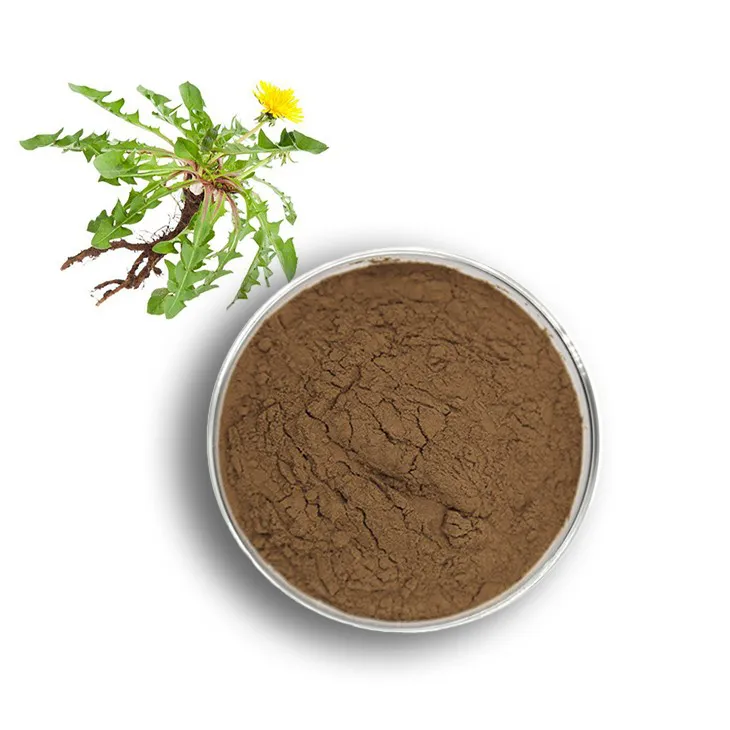- 0086-571-85302990
- sales@greenskybio.com
The Best Types of Dandelion Root Extract: A Guide to Selecting the Best Dandelion Root Extract.
2024-11-14

Introduction
Dandelion Root Extract has been gaining popularity in recent years due to its potential health benefits. However, with the increasing number of products available in the market, it can be challenging to select the best Dandelion Root Extract. This guide will explore the different types of Dandelion Root Extracts, factors to consider when choosing one, and how to ensure you are getting a high - quality product.

Types of Dandelion Root Extracts
1. Alcohol - based Extracts
Alcohol - based dandelion root extracts are commonly used in herbal medicine. The alcohol acts as a solvent, extracting the active compounds from the dandelion root. These extracts are often more concentrated and can have a longer shelf life compared to other types. One advantage of alcohol - based extracts is that they can preserve a wider range of the plant's constituents, including some that may be less soluble in water. However, they may not be suitable for everyone, especially those who avoid alcohol for religious, health, or personal reasons.
2. Water - based Extracts
Water - based dandelion root extracts are a popular alternative for those who prefer non - alcoholic options. These extracts are made by steeping the dandelion root in hot water, similar to making a tea, and then concentrating the resulting liquid. Water - based extracts are generally milder in taste and may be more suitable for those with sensitive stomachs. However, they may not be as potent as alcohol - based extracts in terms of the concentration of certain active compounds.
3. Glycerin - based Extracts
Glycerin - based dandelion root extracts are another option. Glycerin is a sweet - tasting, viscous liquid that can extract the beneficial components from the dandelion root. These extracts are often favored by those who want a more palatable option, as glycerin has a pleasant taste. They are also suitable for those who cannot tolerate alcohol. However, like water - based extracts, they may not be as concentrated as alcohol - based extracts in terms of certain active substances.

Factors to Consider When Selecting Dandelion Root Extract
1. Extraction Method
The extraction method used can significantly impact the quality and effectiveness of the dandelion root extract. As mentioned earlier, different solvents such as alcohol, water, and glycerin can extract different compounds from the root. For example, a well - executed alcohol extraction may yield a more comprehensive range of bioactive compounds compared to a less - refined water extraction. Look for products that describe their extraction process in detail. A high - quality extract is likely to be made using a careful and controlled extraction method to ensure the maximum extraction of beneficial components while minimizing the presence of unwanted substances.
2. Purity
Purity is a crucial factor when choosing a dandelion root extract. A pure extract should contain a high concentration of dandelion root compounds and minimal contaminants. Check the product label for information on purity. Some products may be adulterated with other substances, either accidentally or deliberately. Avoid products that have a long list of unidentifiable ingredients or those that seem to have added fillers. Ideally, the extract should be free from pesticides, heavy metals, and other harmful substances. Organic dandelion root extracts are often a good choice as they are grown without the use of synthetic pesticides and fertilizers, reducing the risk of contamination.
3. Source of the Dandelion Root
The source of the dandelion root can also affect the quality of the extract. Dandelions can be sourced from different regions, and the environmental conditions in which they grow can influence their chemical composition. For example, dandelions grown in nutrient - rich soil may have a higher concentration of certain beneficial compounds. Additionally, wild - harvested dandelions may have different properties compared to those grown in a cultivated setting. Some companies may specifically source their dandelions from pristine natural areas, while others may use dandelions from more common agricultural landscapes. Consider products that provide information about the source of their dandelion roots.
4. Potential Health Benefits
Different people may be interested in dandelion root extract for various potential health benefits. Some of the commonly claimed benefits include digestive support, liver detoxification, and anti - inflammatory effects.
- Digestive Support: Dandelion root has been traditionally used to improve digestion. It may stimulate the production of digestive enzymes and bile, which can aid in the breakdown and absorption of food. If you are looking for a dandelion root extract for digestive support, you may want to look for products that are specifically formulated for this purpose or have testimonials or research related to digestive health.
- Liver Detoxification: The liver is an important organ for detoxifying the body, and dandelion root is thought to support liver function. It may help the liver in filtering toxins and promoting the regeneration of liver cells. For those interested in liver health, look for extracts that mention liver detoxification as a benefit and are backed by scientific research or traditional use.
- Anti - inflammatory Effects: Some studies suggest that dandelion root may have anti - inflammatory properties. This could be beneficial for conditions such as arthritis or other inflammatory disorders. When considering an extract for its anti - inflammatory effects, look for products that have been tested for their anti - inflammatory activity or contain a high concentration of the compounds responsible for this effect.

How to Ensure You Are Getting a High - Quality Product
1. Look for Reputable Brands
Reputable brands are more likely to produce high - quality dandelion root extracts. Look for brands that have a good reputation in the herbal supplement industry. You can check online reviews, ask for recommendations from friends or health professionals, or look for brands that have been in business for a long time. A well - established brand is more likely to have strict quality control measures in place to ensure the purity and effectiveness of their products.
2. Check for Certifications
Certifications can be an indication of the quality of the dandelion root extract. For example, products that are certified organic are more likely to be free from pesticides and other contaminants. Look for certifications such as USDA Organic (in the United States) or equivalent organic certifications in other countries. Additionally, some products may have quality certifications from independent testing laboratories, which can give you more confidence in the product's quality.
3. Read the Product Label Carefully
The product label can provide valuable information about the dandelion root extract. Read it carefully to understand the ingredients, extraction method, and any potential allergens. Make sure the label clearly states the concentration of the dandelion root extract and any other additives. If the label is unclear or lacking in important information, it may be a sign of a lower - quality product.
Conclusion
Selecting the best dandelion root extract requires careful consideration of various factors such as the type of extract, extraction method, purity, source, and potential health benefits. By taking the time to research and evaluate different products, you can increase your chances of finding a high - quality dandelion root extract that meets your specific needs. Whether you are interested in digestive support, liver detoxification, or other potential health benefits, a well - chosen dandelion root extract can be a valuable addition to your wellness routine.
FAQ:
What are the common extraction methods for dandelion root extract?
Common extraction methods for dandelion root extract include solvent extraction, such as using ethanol or water as solvents. Solvent extraction helps to draw out the active compounds from the dandelion root. Another method is supercritical fluid extraction which can be more precise in isolating specific components. Steam distillation can also be used in some cases, especially when extracting volatile components from the dandelion root.
How can one determine the purity of dandelion root extract?
One way to determine the purity of dandelion root extract is through laboratory analysis. Techniques like high - performance liquid chromatography (HPLC) can be used to identify and quantify the different compounds present in the extract. The presence of contaminants or other substances not related to dandelion root can also be detected. Additionally, looking at the manufacturing process and the reputation of the manufacturer can give an indication. Reputable manufacturers are more likely to produce high - purity extracts. Also, the appearance and consistency of the extract can sometimes be a clue, although this is not as accurate as laboratory analysis.
What are the potential health benefits of dandelion root extract?
Dandelion root extract may have several potential health benefits. It is often associated with digestive health as it can stimulate bile production, which aids in digestion. It may also have diuretic properties, helping the body to eliminate excess water. Some studies suggest that it has antioxidant effects, which can help combat oxidative stress in the body. Additionally, it may have anti - inflammatory properties, potentially useful for conditions related to inflammation. However, more research is needed to fully understand and confirm these benefits.
Are there different grades of dandelion root extract?
Yes, there are different grades of dandelion root extract. The grade can be determined by factors such as purity, concentration of active ingredients, and the quality of the raw materials used. Higher - grade dandelion root extracts are likely to have a higher concentration of beneficial compounds and fewer impurities. They are often produced using more advanced extraction and purification techniques. Lower - grade extracts may be less pure and have a lower concentration of the desired components.
How should dandelion root extract be stored?
Dandelion root extract should be stored in a cool, dry place away from direct sunlight. It is often best to store it in an airtight container to prevent oxidation and contamination. The ideal storage temperature is usually around room temperature or slightly cooler. If the extract is in a liquid form, it may need to be stored in a refrigerator to maintain its stability and potency for a longer period. It is also important to follow any specific storage instructions provided by the manufacturer.
Related literature
- Dandelion Root Extract: Properties, Applications, and Future Perspectives"
- "The Science Behind Dandelion Root Extract and Its Health - Promoting Effects"
- "Extraction Methods of Dandelion Root Compounds: A Review"
- ▶ Hesperidin
- ▶ Citrus Bioflavonoids
- ▶ Plant Extract
- ▶ lycopene
- ▶ Diosmin
- ▶ Grape seed extract
- ▶ Sea buckthorn Juice Powder
- ▶ Fruit Juice Powder
- ▶ Hops Extract
- ▶ Artichoke Extract
- ▶ Mushroom extract
- ▶ Astaxanthin
- ▶ Green Tea Extract
- ▶ Curcumin
- ▶ Horse Chestnut Extract
- ▶ Other Product
- ▶ Boswellia Serrata Extract
- ▶ Resveratrol
- ▶ Marigold Extract
- ▶ Grape Leaf Extract
- ▶ New Product
- ▶ Aminolevulinic acid
- ▶ Cranberry Extract
- ▶ Red Yeast Rice
- ▶ Red Wine Extract
-
Coix Seed Extract
2024-11-14
-
Polygonum multiflorum extract
2024-11-14
-
Lemon Balm Extract
2024-11-14
-
Stevia Extract
2024-11-14
-
Longan Extract
2024-11-14
-
Uridine-5'-monophosphate Disodium salt
2024-11-14
-
Wheat Germ Extract
2024-11-14
-
Elderberry Extract
2024-11-14
-
Pine bark Extract Powder
2024-11-14
-
Bayberry Extract
2024-11-14





















